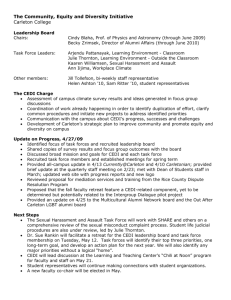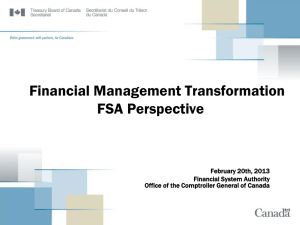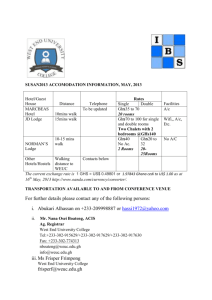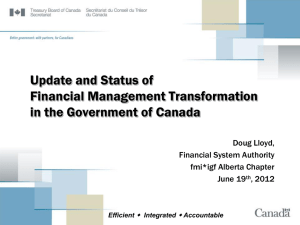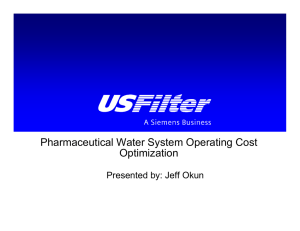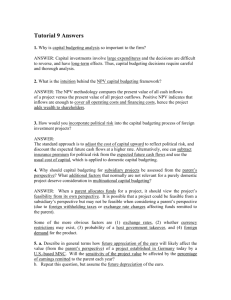Process and System Design for Reliable Operation of RO
advertisement
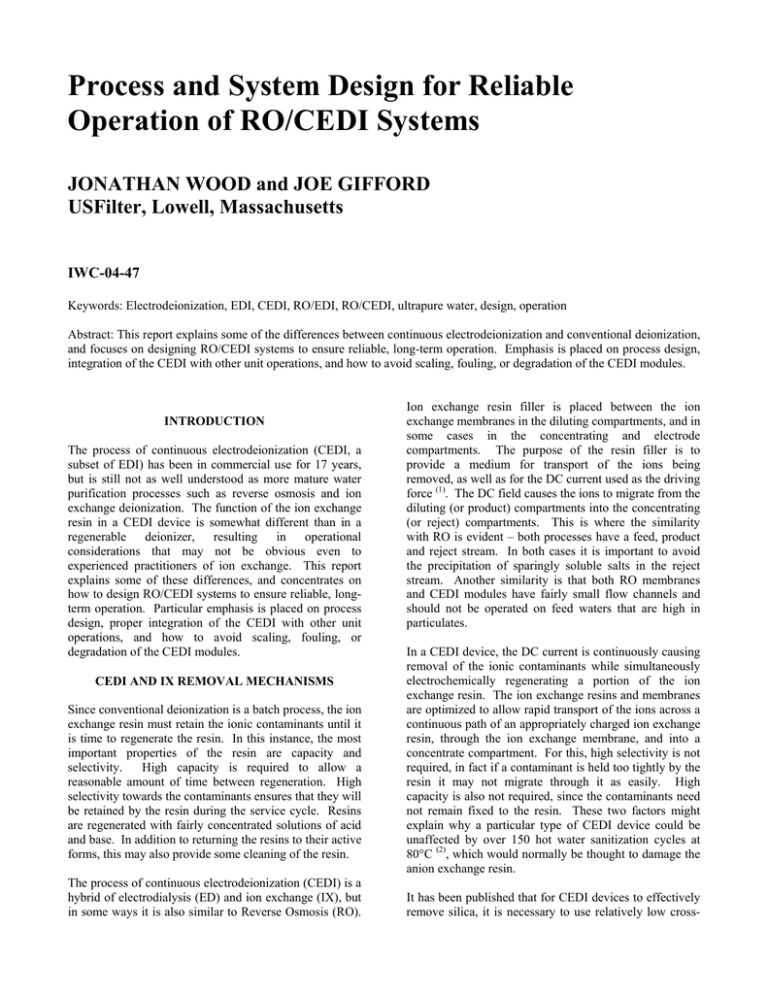
Process and System Design for Reliable Operation of RO/CEDI Systems JONATHAN WOOD and JOE GIFFORD USFilter, Lowell, Massachusetts IWC-04-47 Keywords: Electrodeionization, EDI, CEDI, RO/EDI, RO/CEDI, ultrapure water, design, operation Abstract: This report explains some of the differences between continuous electrodeionization and conventional deionization, and focuses on designing RO/CEDI systems to ensure reliable, long-term operation. Emphasis is placed on process design, integration of the CEDI with other unit operations, and how to avoid scaling, fouling, or degradation of the CEDI modules. INTRODUCTION The process of continuous electrodeionization (CEDI, a subset of EDI) has been in commercial use for 17 years, but is still not as well understood as more mature water purification processes such as reverse osmosis and ion exchange deionization. The function of the ion exchange resin in a CEDI device is somewhat different than in a regenerable deionizer, resulting in operational considerations that may not be obvious even to experienced practitioners of ion exchange. This report explains some of these differences, and concentrates on how to design RO/CEDI systems to ensure reliable, longterm operation. Particular emphasis is placed on process design, proper integration of the CEDI with other unit operations, and how to avoid scaling, fouling, or degradation of the CEDI modules. CEDI AND IX REMOVAL MECHANISMS Since conventional deionization is a batch process, the ion exchange resin must retain the ionic contaminants until it is time to regenerate the resin. In this instance, the most important properties of the resin are capacity and selectivity. High capacity is required to allow a reasonable amount of time between regeneration. High selectivity towards the contaminants ensures that they will be retained by the resin during the service cycle. Resins are regenerated with fairly concentrated solutions of acid and base. In addition to returning the resins to their active forms, this may also provide some cleaning of the resin. The process of continuous electrodeionization (CEDI) is a hybrid of electrodialysis (ED) and ion exchange (IX), but in some ways it is also similar to Reverse Osmosis (RO). Ion exchange resin filler is placed between the ion exchange membranes in the diluting compartments, and in some cases in the concentrating and electrode compartments. The purpose of the resin filler is to provide a medium for transport of the ions being removed, as well as for the DC current used as the driving force (1). The DC field causes the ions to migrate from the diluting (or product) compartments into the concentrating (or reject) compartments. This is where the similarity with RO is evident – both processes have a feed, product and reject stream. In both cases it is important to avoid the precipitation of sparingly soluble salts in the reject stream. Another similarity is that both RO membranes and CEDI modules have fairly small flow channels and should not be operated on feed waters that are high in particulates. In a CEDI device, the DC current is continuously causing removal of the ionic contaminants while simultaneously electrochemically regenerating a portion of the ion exchange resin. The ion exchange resins and membranes are optimized to allow rapid transport of the ions across a continuous path of an appropriately charged ion exchange resin, through the ion exchange membrane, and into a concentrate compartment. For this, high selectivity is not required, in fact if a contaminant is held too tightly by the resin it may not migrate through it as easily. High capacity is also not required, since the contaminants need not remain fixed to the resin. These two factors might explain why a particular type of CEDI device could be unaffected by over 150 hot water sanitization cycles at 80°C (2), which would normally be thought to damage the anion exchange resin. It has been published that for CEDI devices to effectively remove silica, it is necessary to use relatively low cross- linked (high water content) ion exchange resins (3). We believe this is due to the bulky nature of the ortho-silicic acid molecule, with its associated waters of hydration (4). Reducing the cross linking of the ion exchange resin facilitates the transport of silica (and other large molecules) through the ion exchange resins. The same is true of the ion exchange membranes. While lowering the cross-linking reduces the mechanical stability of the ion exchange resin, this is generally not an issue with CEDI devices, since they do not subject the resin to the physical attrition of regular backwashing or the osmotic shock of frequent chemical regeneration. However, low crosslinked resins are sensitive to oxidants, and incomplete removal of chlorine can have a catastrophic effect on a CEDI module, as it can with a polyamide RO membrane. CEDI FEED WATER REQUIREMENTS When CEDI was first commercialized in 1987, many of the first installations were on softened tap waters, as an alternative to two-bed demineralization. A significant amount of additional pretreatment was also required, including activated carbon dechlorination, cartridge filtration, and in some cases organic scavenging. While some such systems have remained in service over 15 years, the use of CEDI on tap water is no longer common. Now virtually all new CEDI systems require RO pretreatment. This allows the CEDI device to make mixed-bed quality water, and provides more reliable operation of the CEDI system. CEDI feed water requirements can be divided into two categories. The first relates to the performance of the module. Feed water TDS and carbon dioxide limits, as well as minimum temperature must be specified so that the device can achieve the desired performance. Increasing the TDS or CO2 in the feed water would not cause permanent damage to the module, but it may impact the product quality. The second category includes items that could damage the module, such as high temperature and pressure or foulants like organics and hardness. The feed water requirements for several different manufacturers’ commercially available CEDI devices are shown in Table 1. Most of these requirements can be easily met by pretreatment with single or double-pass RO. PROCESS DESIGN CONSIDERATIONS Hardness Table 1 shows that most CEDI devices can only tolerate about 1 ppm of total hardness, and in some cases the recommended hardness is as low as 0.1 ppm. This is often surprising to those familiar with saturation indices such as the Langelier Saturation Index (LSI), since in most cases the LSI of the bulk CEDI reject stream will be negative. However, the water splitting that is necessary for electrochemical regeneration of the ion exchange resin can also lead to localized pH shifts, creating regions (such as near the ion exchange membrane surface) where the scaling potential is greater than in the bulk solution. TABLE 1 Feed water requirements for various CEDI devices Parameter A B C D RO RO RO RO Feed water type permeate permeate permeate permeate Conductivity, µS/cm CO2, ppm TEA (ppm as CaCO3) Silica (SiO2) Fe, Mn, H2S Total Cl2 Free Cl2 Hardness, ppm CaCO3 TOC pH Temperature, °C Pressure, psig Recovery, % DP, psid a b c d < 40 4 – 30 < 14 < 10 a < 25 < 1.0 < 0.01 < 0.02 < 0.5 < 0.01 ≤ 25 < 0.5 < 0.01 < 0.05 b < 0.05 < 1.0 < 0.5 ≤ 10 ≤ 0.5 ≤ 0.01 ≤ 0.05 < 1.0 c ≤ 2.0 d < 0.5 4-11 < 0.5 5-9 < 0.5 5 – 9.5 ≤ 0.5 6–9 5 - 45 4.4-38 5 – 35 5 – 38 25 - 100 45 - 100 < 60 36 – 100 90 - 95 25 - 35 90 - 95 20 - 35 10 - 30 80 – 95 22 – 36 < 5 ppm CO2 recommended recommended non detectable < 0.1 ppm CaCO3 recommended recommended non detectable There are four main system configurations used to meet the feed water hardness limits of CEDI systems: Softening/RO/CEDI Antiscalant/RO/Softening/CEDI Antiscalant/RO/CEDI Antiscalant/RO/RO/CEDI Which configuration is used depends on such factors as the raw water hardness, TDS, and even silt density index (since softening can help reduce RO membrane fouling). While the RO system alone (with antiscalant pretreatment instead of softening) may be able to produce steady-state permeate hardness of less than 1 ppm, proper system design is required to ensure the hardness does not exceed this concentration. For example, most boiler makeup water systems operate in “start/stop” mode, only operating when the deionized water storage tank is calling for water. When an RO system starts up from a standby condition, the initial slug of RO permeate can be worse than the RO feed water (since at low salt concentration there is little osmotic/water flow and the concentration gradient causes salts to continue to diffuse through the RO membrane after the permeate flow stops), and the first few minutes of RO permeate may not meet the CEDI system feed water specifications. This phenomenon is illustrated for permeate conductivity in Figure 1, but the results are similar for most ionic constituents in the feed water, and perhaps even for TOC. In this particular instance, it took about 2 minutes for the RO permeate to approach steady-state. Even though the volume is relatively small, it is important to flush this water to drain or back to the inlet of the RO rather than send it to the CEDI system, especially since most RO/CEDI systems do not have a buffer tank between the RO and CEDI. An alternative approach is to flush the RO system with demineralized water before it shuts off. Figure 1 Rinse-down of an RO system after standby (raw water conductivity of 250 µS/cm) RO Permeate, µS/cm 500 400 300 Conductivity 200 100 0 0 50 100 150 200 250 Time, seconds In some cases the steady-state permeate hardness from an RO system will not meet the feed specification of the CEDI module. In this case, it is possible to install an ion exchange softener between the RO and CEDI. This allows the use of a smaller softener (as the RO permeate flow is usually 75% of the RO feed flow) and it will be removing very low levels of hardness so that regeneration frequency will be much lower than for a softener upstream of the RO. Whenever using a sodium cycle softener between the RO system and the CEDI system, it is important to thoroughly regenerate and flush the softener resin when first putting the system into service. This is because new cation exchange resin contains extractables that could foul the anion resin in the downstream CEDI system. A resin trap between the softener and CEDI is also advisable. Carbon Dioxide Another significant issue affecting CEDI operation is the presence of carbon dioxide (CO2) in the feed water. Any CO2 in the gaseous form will not be rejected by the RO membrane, and will impart an ionic “load” on the downstream CEDI system. For some CEDI devices, a concentration of 10 ppm CO2 in the CEDI feed may be enough to prevent the system from meeting the boiler makeup water specifications. Therefore, RO/CEDI systems may employ a separate means of CO2 removal. The most common methods are forced draft degasification, membrane degasification, or increasing the pH before the RO to convert the CO2 to bicarbonate, which can be rejected by the RO. Dosing caustic also increases the LSI of the RO feed and reject water and may only be practical if the RO feed water is softened. It is also sometimes employed between passes of a two-pass (product-staged) RO system (5). Since the reject stream from a CEDI system typically contains anywhere from one fifth to one half the salt concentration of the raw water, recycling the CEDI reject to the inlet of the RO is often desired. This may be possible, but it is necessary to consider that while the CEDI reject may be lower in salt, it typically has ten times the CO2 of the RO feed water, as shown in Figure 2 (because the RO passes CO2 and then CEDI removes it). In the absence of a degasification or pH adjustment step, recycling this water could result in as high as a three-fold increase in the CEDI feed CO2 concentration, and could have a significant impact on the CEDI product water quality. In most cases this would be impractical without a CO2 removal step as part of the process train. Figure 2 CO2 concentrations in an RO/CEDI system RO [1] CEDI [3] [2] [4] Estimated for 70% RO and 90% CDI recovery, neglecting CO2 lost by venting Location Initial ppm NaCl Initial ppm CO2 Steady-state ppm NaCl Steady-state ppm CO2 [1] Raw water 500 5 500 5 [2] RO [3] CEDI [4] CEDI feed feed reject 500 10 100 5 5 50 < 500 < 10 < 100 15.6 15.6 156 Oxidants Oxidants such as free and total chlorine (which are found in many raw waters), as well as ozone or hydrogen peroxide (which may be used in a plant for sanitization), can irreversibly damage the ion exchange resin and ion exchange membranes in a CEDI device. Oxidative attack can cause breakdown of the cross-linking in cation and anion resins as well as degradation of the functional exchange sites. This results in both poor salt removal performance as well as physical breakdown of the resin leading to increased pressure drop (or decreased flow) through any resin-filled compartments. Chlorine - or any other oxidant - should be removed to essentially non-detectable levels before the CEDI. Because the CEDI resin is selected for performance rather than durability, even low concentrations of oxidant can cause permanent damage in a short amount of time. Examination of oxidized CEDI devices has shown that the most obvious damage occurs to the resin in the first few inches (inlet) of the cell. In most CEDI devices it is either not possible or not practical to remove and replace only the damaged resin. Therefore in most instances of oxidation it is necessary to replace all of the ion exchange resin. Since the oxidant may either directly or indirectly lead to damage of the ion exchange membranes, it usually makes sense to replace all the membranes at the same time. Because of the potential expense and downtime involved, it is worthwhile to take all necessary precautions to prevent the possibility of oxidation. There are two main methods for removal of chlorine in process water systems – flow through a granular activated carbon bed or injection of a reducing agent (such as sodium sulfite or sodium bisulfite). Although it is the more expensive option, activated carbon would normally be preferred because it is the most reliable dechlorination process. If breakthrough does occur, it will be relatively gradual and normally would be detected before serious damage to the CEDI system. Chemical dechlorination can achieve complete reduction of chlorine, but failure could result in an immediate increase to the feed level. Finding the correct injection rate is like walking a tightrope, where underdosing could result in oxidation and overdosing could cause severe biological fouling of the RO system. For this reason, it is common practice to use an oxidation-reduction potential (ORP) monitor or a residual sulfite monitor as part of the control system for dosing of the reducing agent. The latest development in dechlorination is the use of ultraviolet (UV) reactors, with either low-pressure or medium-pressure UV lamps. This is generally more effective for destruction of free chlorine than for chloramines. The former would require UV dosage of 1530 times the disinfection dosage of 30,000 µW/cm (6), while the latter may require 100 times this amount. The required dosage depends on the amount of chlorine/chloramines in the feed water, and we have found that it can be difficult to achieve non-detectable chlorine through the use of UV alone. Temperature Temperature can have a significant effect on performance of CEDI devices. As the feed water temperature decreases, reaction kinetics and diffusion rates slow and CEDI module electrical resistance increases, causing an increase in the required voltage and perhaps a decline in performance. Therefore, to maintain rated performance specifications, most CEDI manufacturers recommend a minimum temperature. Most CEDI devices also have a maximum operating temperature, usually determined by the materials used to construct the flow compartments (plastics or elastomers). While the maximum operating temperature varies with manufacturer, it is generally in the range of 35-45°C. Some CEDI modules are constructed to allow periodic sanitization with hot water (65-85°C). Such sanitization is always performed with the DC power off, and usually at a reduced pressure of 10-30 psig. In most applications, water temperature is addressed during system design, by adding appropriate heating or cooling devices. However, occasionally RO and CEDI systems are used in recirculating loops. These loops can operate for long periods of time with little drawoff. Under this condition, the water can heat up due to the recirculation pump. This can lead to unacceptably high water temperature and should be addressed with alarms and automatic cooling or draw-off to maintain acceptable temperature. Another cause of high temperature in a CEDI device could be the applied DC power. Under normal operation, the heat loss into the water due to the DC power is hardly noticeable. However, if water flow through the module is reduced to a low enough level, this heating can cause the water temperature to exceed the manufacturer’s specification and cause permanent damage to components including the resins and membranes. For this reason, it is imperative that controls be designed to prevent the DC power from being on without water flow through the CEDI module. Redundant protection is advisable. Water Recovery For most CEDI systems the water recovery is typically about 90-95%. Water recovery is limited for several reasons. Limiting the concentrations of sparingly soluble salts helps to avoid precipitation (scaling) in the concentrate cells. The most common types of scale encountered in CEDI devices consist primarily of calcium or silica. Therefore, the maximum allowable feed water concentrations of these contaminants may be linked to the recovery. For example, operation at 95% recovery normally requires a feed hardness of <0.2 ppm, while at 90% recovery 1.0 ppm hardness may be allowed. As the recovery increases, the reject salt concentration also increases. This causes a large concentration gradient across the membrane, leading to the potential for crossleaks or back-diffusion and reduced product quality. Cross-leaks are normally addressed by balancing the pressure between compartments, as discussed later. Back diffusion is prevented by limiting the recovery. Total Organic Carbon Most CEDI module manufacturers have set a specification of less than 0.5 ppm of total organic carbon (TOC) in the feed water. This specification is empirical based on years of operational experience. It is very difficult to set an absolute value due to the fact that TOC is a non-specific analysis, and the actual organic species that make up this number vary significantly by location and also seasonally. For the most part, RO pretreatment will reduce TOC below the 0.5 ppm level, and typically will remove the majority of the large organic molecules known to be fouling to ion exchange resin. Electrode gases Gases are formed at the electrodes of a CEDI device, as shown in Equations 1, 2 and 3. At the cathode: H2O+ e- → ½ H2 + OH- Equation 1 At the anode: ½ H2O → ¼ O2 + H+ + eEquation 2 and Equation 3 Cl- → ½ Cl2 + eSince CEDI devices operate at low current density (compared to electrodialysis), the quantity of gas formed is relatively small. At standard conditions of 25°C and 1 atmosphere, approximately 11 ml/min of gas (7.5 ml/min H2 and 3.7 ml/min O2) are produced per amp of current. These gases are removed by flushing water over the surface of the electrodes during operation. Commercial devices exist utilizing either down-flow or up-flow flushing through the electrode compartments, so both can be effective for gas removal. In some CEDI devices, product water is passed over the electrodes. In this case a gas removal step may have to be employed prior to use of the product water. In other devices, a small stream of water is sent to the electrodes and then to drain or reuse in other plant applications. In still other devices, the electrode water is combined with the reject water inside the module. In this case, the reject water may have to be vented before recycling. Depending on the configuration of the electrode compartments and the composition of the electrode feed water, some chlorine can be formed at the anode, as shown in Equation 3. Concentrations in the range of nondetectable to 8 ppm Cl2 have been observed (2), the higher values in a system with concentrate salt injection. This will also have to be taken into consideration when recycling or reusing the electrode and/or reject water. CEDI SYSTEM DESIGN CEDI modules are commercially available in sizes from less than 1 gpm to 80 gpm, in both plate-and-frame and spiral wound configuration, and with screen-type or resinfilled concentrate and electrode compartments. The design of the CEDI system can vary widely depending on the size and type of CEDI module used. Hydraulic Controls and Instrumentation For CEDI systems using a large number of small (10-15 gpm) modules in parallel, the system design approach is similar to an RO system, with the CEDI module analogous to an RO element. Control and instrumentation are provided at the system level, not the module level. On systems with a small number of large modules it may be practical to have independent controls and instrumentation for each module. In either case, there is a minimum amount of system control and instrumentation required, including the following: Product (dilute) flow meter Product low flow switch Product inlet/outlet pressure gauges Reject (concentrate) flow meter Reject low flow switch Reject inlet/outlet pressure gauges DC voltmeter DC ammeter Product conductivity or resistivity Dilute inlet valve Dilute outlet valve Concentrate inlet valve Concentrate outlet valve Shutdown interlock with RO or feed pumps In addition, concentrate recirculation requires: Recirculation flow meter Pump control valve or variable speed drive Makeup valve Bleed valve Systems with brine injection may also need: Brine low level alarm Concentrate conductivity controller Typical P&I Ds are shown in Figure 3 and Figure 4 for two different CEDI module types. One of the main considerations in the hydraulic controls is to provide the ability to balance the pressure differential between the product and reject compartments. Typically the product outlet pressure is maintained about 2-5 psi above the reject outlet pressure, to prevent the possibility of crossleaks from the concentrate side to the dilute side. In once through systems this is accomplished with straightforward adjustment of the concentrate inlet and outlet valves. It is more complicated with concentrate recirculation. DC Power Supply The power supply simply converts the AC line voltage to the DC voltage used as the driving force for the electrodeionization process. Therefore its function is analogous to the high pressure pump in a RO system. There are two modes of power supply control, constant voltage and constant current. In constant voltage mode the DC voltage is fixed, and the DC current will vary with the electrical resistance of the CEDI stacks. For example, if the feed water temperature drops, the ohmic resistance of the stacks will increase, and the amperage will go down. Many CEDI systems successfully employ this mode of power supply operation, but it may require occasional manual adjustment of the voltage to maintain the desired DC current and product water quality. Constant current operation is when the power supply is designed to automatically adjust the DC voltage as necessary in order to maintain the DC amperage at a preset value. This avoids the need for manual adjustment in response to changes in stack resistance, but does not necessarily eliminate operator intervention, since the amount of current required by the CEDI system varies with the product flow rate and the ionic load in the feed water. The ideal power supply design would provide a separate rectifier for each CEDI module in the system. Then if one rectifier fails, the rest of the system can remain in operation while the damaged rectifier is being repaired or replaced. Having individual rectifiers also offers some degree of flexibility in monitoring, control and optimization of the DC power applied to each module. On very large systems individual DC power supplies may not be practical, so some CEDI systems with many small modules employ a single large DC power supply. In this instance all the modules operate at the same applied voltage, and the resulting current is divided up among the individual modules according to their electrical resistance. It is still possible to use constant-current operation, but it is the DC current of the entire system that is controlled to a setpoint, and the current through the individual modules can vary somewhat. This can result in some performance variation between modules, so such systems should be evaluated on the overall system performance rather than that of individual modules. One of the most important operating parameters of a CEDI system is the electrical resistance of the module(s) – the applied DC voltage divided by the resulting DC current. An increase in electrical resistance may indicate a problem such as the precipitation of hardness on the surface of the ion exchange membrane. The sooner such a problem is identified and corrected, the greater the chance that aggressive maintenance can be avoided. CEDI MODULE DESIGN In addition to the process issues already discussed, there are some CEDI module construction features that can have an impact on module longevity and maintenance requirements. External Leaks During the first decade of continuous electrodeionization, the stacks were not leak-free, and in many cases were provided with a drip pan to collect the small amount of water weeping from the cells. This did not compromise salt removal, and many such devices have been in operation for over a dozen years. More recently, end users have been asking for devices that are capable of higher operating pressure (up to 100 psig) with zero external leakage. Two approaches to attaining this goal have been the use of thick cells or putting the cells in a housing. The 8-10 mm resin compartments used in thick cell devices are inherently stronger than the 3 mm spacers used in thin cell devices. They also allow the use of true O-ring seals, which can be used to guarantee the absence of external leaks. Figure 3 Typical P&ID for CEDI system using module(s) with resin-filled concentrate and electrode compartments (once-through operation) Figure 4 Typical P&ID for CEDI system using module(s) with screen-type concentrate and electrode compartments. This system includes concentrate recirculation and concentrate salt injection. There are now a few commercial CEDI modules that contain the cells inside a cylindrical housing. This has been done with both spiral wound and stacked-disk type (7) devices. The stacked disk device incorporates O-ring seals in addition to an FRP housing, and is warranted against external leakage. One of the spiral devices has experienced problems of resin seepage and resin loss (8), although these claim to have been resolved by a recent design change. Salt bridging Many plate and frame CEDI devices expose the edge of the ion exchange membrane to the ambient air. Such devices are susceptible to the buildup of salt deposits on the outside of the modules. This may be as a result of water weeping out the concentrate compartment gasket, or possibly from water “wicking” out the edge of the membrane. When the water evaporates, any salt it contained is left behind. If these deposits are not removed, they can build up to the point where they form a bridge between the cell pairs and the metallic frame of the device. Such salt bridges can provide an alternative path for the DC current, leading to arcing that could in turn lead to module damage. Salt bridging is more of an issue if the concentrate conductivity is high. This is the case in some CEDI systems with screen-type concentrate spacers that require salt injection into the concentrate stream to reduce the stack electrical resistance. Salt injection is not required in devices with resin-filled concentrate and electrode spacers. It is possible to prevent the formation of salt bridging by eliminating all external leaks (as described above) and by preventing the loss of water out the edge of the ion exchange membrane. The latter can be accomplished by completely surrounding the membrane with an O-ring seal, so that it is not exposed to the air. Biofouling Biological fouling has been observed in some CEDI installations, and in the authors’ experience it usually occurs in an area of the screen-type concentrate spacers that is outside the electric field (the inlet section above the electrode and the outlet section below the electrode). Biofilm is very seldom seen in resin-filled compartments of a CEDI device, nor is it seen in the open channels leading into and out of the resin chambers. These observations suggest that (1) the electric field suppresses biological growth and (2) the geometry of the screen type flow spacer is more susceptible to biological growth than a more open channel. It is also believed that recirculation of the concentrate stream may contribute to biological fouling, as some experts have raised these concerns regarding the use of reject recirculation with reverse osmosis systems (9), and fewer biofouling problems have been experienced in CEDI systems with once-through operation. CONCLUSIONS CEDI technology has matured, but it is not yet as well understood as RO. Ensuring long-term, reliable operation of CEDI systems involves elements of module, system and process design. It is important to properly integrate the design and operation of the pretreatment, RO, and CEDI systems. Issues of particular importance are removal of hardness and chlorine. With proper system design and operation, expected CEDI module life is over 5 years, and some systems have achieved continuous operation of over 15 years. REFERENCES (1) Ganzi, G.C., Y. Egozy, A.J. Giuffrida, and A.D. Jha, High Purity Water by Electrodeionization: Performance of the Ionpure (tm) Continuous Deionization System, Ultrapure Water, Vol. 4, No. 3, pp. 43-50 (1987). (2) Gifford, J and Atnoor, D. An Innovative Approach to Continuous Electrodeionization Module and System Design for Power Applications, International Water Conference, October 2000. (3) Ganzi, G. et. al., Electrodeionization Apparatus, U.S. Patent No. 5,316,637. (4) Iler, R.K., The Chemistry of Silica, John Wiley & Sons, 1979 (5) Pittner, G, Reverse Osmosis System, U.S. Patent No. B1 4,574,049. (6) Shipe, B. A., The Use of UV in Dechlorination Applications, Water Technology (August 2002). (7) Liang, L, Evolution in Design of CEDI Systems, Ultrapure Water, Vol. 20, No. 8, pp. 13-18 (October 2003). (8) Li, X and Luo, G, EDI Device With Resin SeepageProof Inserts, U.S. Patent Application 2004/0112752 A1. (9) Quinn, R, presentation at Membrane Technology/ Separations Planning Conference, Newton, MA, 1997.
